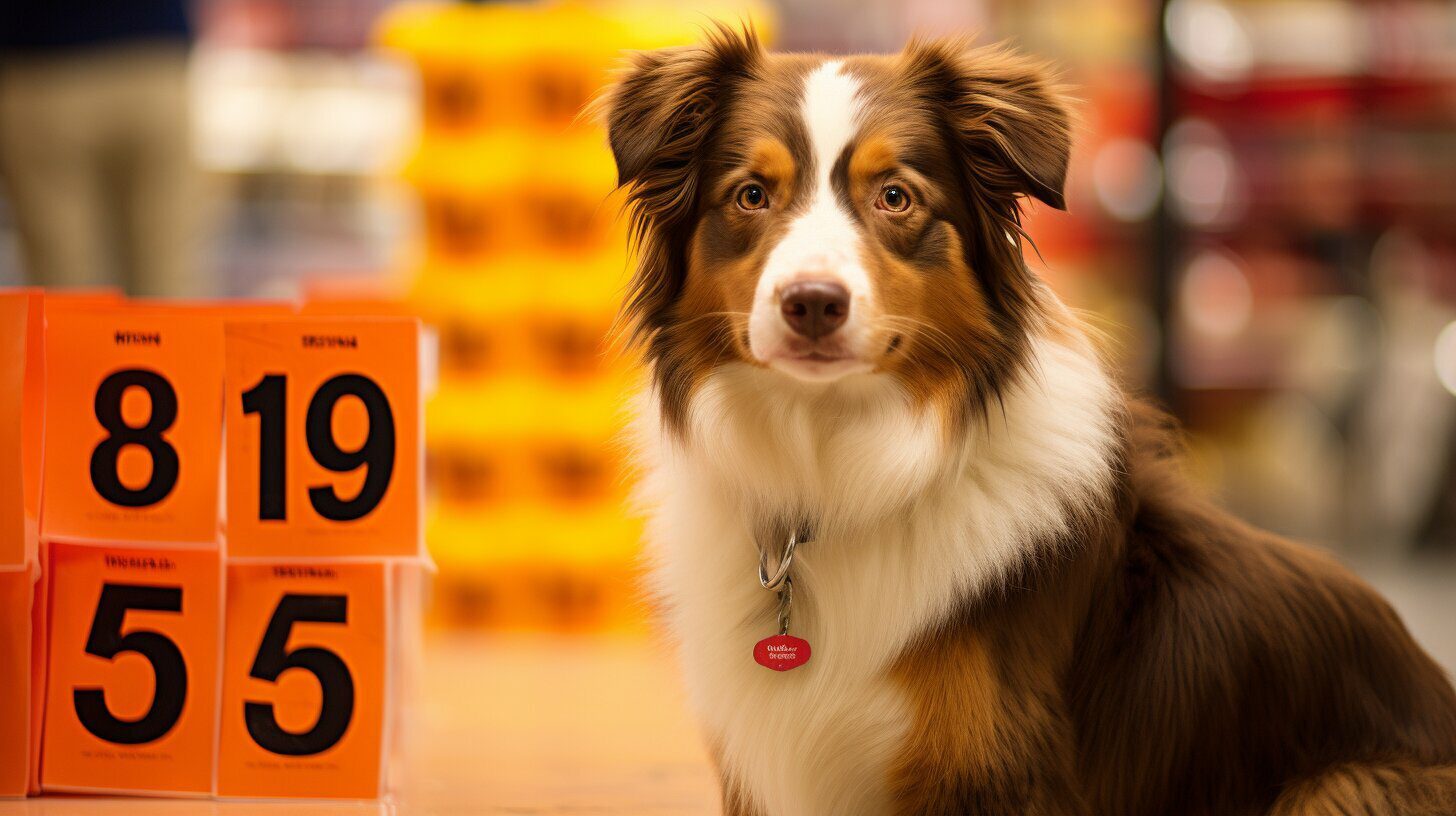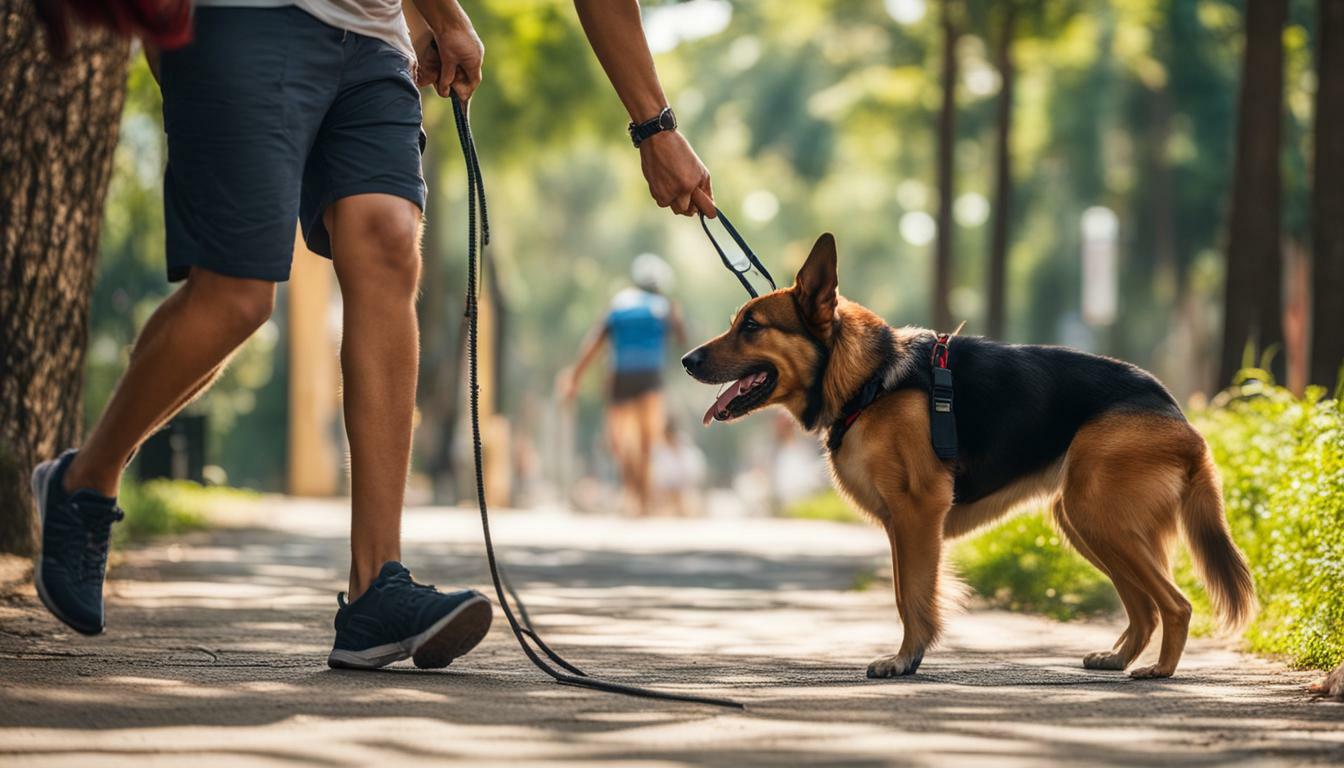
As a responsible dog owner, it is crucial to know how hot is too hot to walk your furry friend safely. When it comes to walking dogs in hot weather, it is important to consider the temperature, humidity, and whether there is a breeze. Experts advise that temperatures up to 68F are generally safe for walks, but anything over 77F is considered risky. It is essential to be mindful of different dog sizes and breeds, as well as any underlying health issues. Large, obese, flat-faced, and very young dogs are at a higher risk in temperatures above 75F.
- Temperatures up to 68F are generally safe for dog walking in hot weather
- Avoid walking dogs when temperatures exceed 77F to minimize risks
- Large, obese, flat-faced, and very young dogs are more susceptible to heat-related issues
- Plan walks during cooler times of the day, such as early morning or late evening
- Check the ground temperature before walking to avoid hot pavement burns on dog’s paws
Factors to Consider When Walking Dogs in Hot Weather
When deciding whether it’s safe to walk your dog in hot weather, there are several factors you should consider. Temperature, humidity, and the presence of a breeze can all affect your dog’s comfort and well-being during a walk. Experts recommend that temperatures up to 68°F are generally safe for walks, but anything over 77°F is considered risky.
It’s important to keep in mind that different dog sizes and breeds may have different temperature limits. Large, obese, flat-faced, and very young dogs are at a higher risk in temperatures above 75°F. These dogs may have a harder time regulating their body temperature and are more susceptible to heat-related illnesses. If your dog falls into any of these categories, it’s crucial to take extra precautions when walking them in hot weather.
Planning your walks during hot weather can also help minimize the risks. Opting for early morning or late evening walks when temperatures are lower can help keep your dog comfortable. Before stepping out, be sure to check the ground temperature. Hot pavement can quickly heat up and burn your dog’s paw pads. If the pavement feels hot to the touch, consider walking your dog on grass or dirt paths instead.
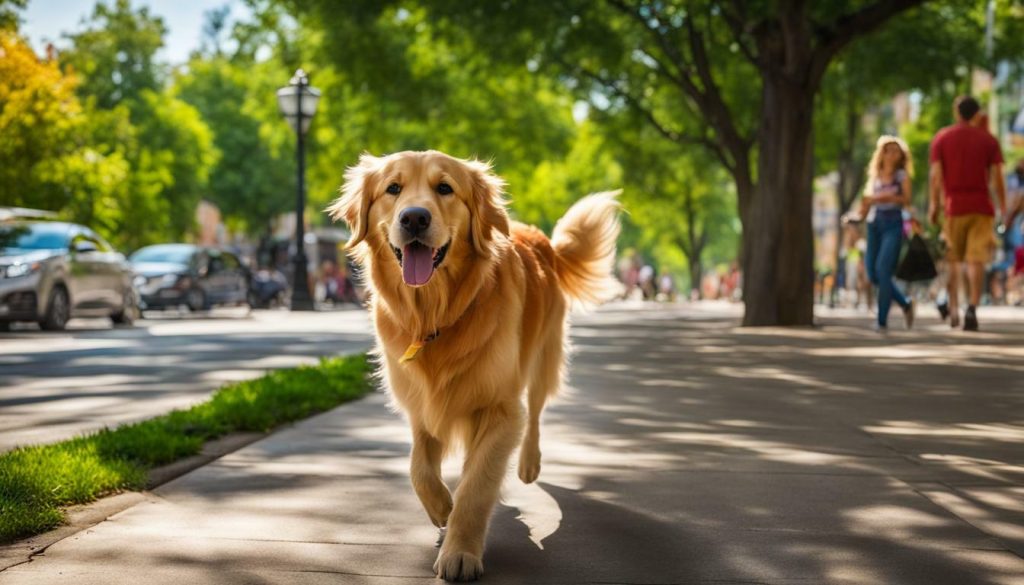
During hot weather walks, it’s important to adjust the duration and intensity of the walk based on the heat. Shorter walks and less intense exercise can help prevent overheating and exhaustion. To keep your dog hydrated, bring along a collapsible water bowl and fresh water. Offering your dog regular water breaks is essential to prevent dehydration and heatstroke.
Remember never to leave your dog unattended in a hot car, even for a short period. Cars can quickly become dangerously hot, putting your dog’s life at risk. If you need to run errands, find alternatives such as leaving your dog at home or using drive-through services that allow dogs. It’s always better to be safe than sorry when it comes to your furry friend’s well-being.
Temperature Guidelines for Dog Walking
To ensure the safety of your canine companion, it’s essential to be aware of the temperature limits for dog walking. Experts recommend considering factors such as temperature, humidity, and the presence of a breeze before taking your dog out for a walk. Dogs are more susceptible to overheating than humans, so it’s important to take precautions and adjust your routine accordingly.
When it comes to temperature, experts advise that temperatures up to 68F are generally safe for walks. However, anything over 77F is considered risky and should be avoided. It’s important to keep in mind that different dog sizes and breeds may have different tolerances for heat. For example, large breeds, flat-faced breeds, obese dogs, and very young dogs are at a higher risk in temperatures above 75F.
To protect your dog from the dangers of hot weather, it’s recommended to plan your walks during the cooler parts of the day, such as early mornings or late evenings when temperatures are lower. Before stepping out, take a moment to check the ground temperature. Hot pavement can quickly burn a dog’s paws, so it’s important to avoid surfaces that are too hot. Opting for dirt paths or grassy areas can help prevent burns and keep your furry friend comfortable.
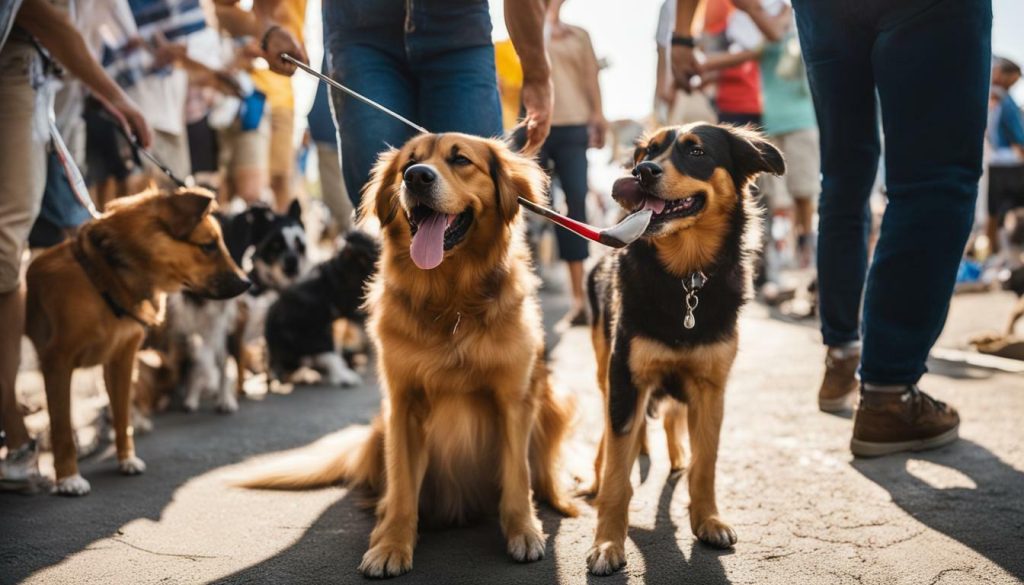
During hot weather walks, it’s crucial to adjust the duration and intensity of the walk to prevent overheating. Shorter walks and less intense exercise can help keep your dog cool and reduce the risk of heat-related issues. Don’t forget to bring along a collapsible water bowl and fresh water to keep your dog hydrated. Regular water breaks are essential to prevent dehydration and heatstroke.
Summary of Temperature Guidelines for Dog Walking:
- Temperatures up to 68F are generally safe for dog walking
- Avoid walking dogs in temperatures exceeding 77F
- Large breeds, flat-faced breeds, obese dogs, and very young dogs are at higher risk in temperatures above 75F
- Plan walks during cooler parts of the day, like early mornings or late evenings
- Avoid hot pavement to prevent burns on your dog’s paws
- Adjust the duration and intensity of walks based on the heat
- Bring a collapsible water bowl and fresh water to keep your dog hydrated
By following these temperature guidelines and taking necessary precautions, you can ensure that your dog stays safe and comfortable during hot weather walks. Remember, your furry friend relies on you to prioritize their well-being, so be mindful of the weather conditions and adjust your plans accordingly.
| Temperature | Safe for Dog Walking |
|---|---|
| Up to 68F | Generally safe |
| Above 77F | Risky, avoid walking |
Dogs at Higher Risk in Hot Weather
Certain dog breeds and certain characteristics can put your furry friend at a higher risk in hot weather. Large breeds like St. Bernards and Newfoundlands have a harder time regulating their body temperature in hot climates, making them more susceptible to heat-related illnesses. Additionally, flat-faced breeds such as Bulldogs and Pugs have smaller airways, making it more difficult for them to cool down through panting.
Young dogs are also at a higher risk in hot weather due to their underdeveloped thermoregulation systems. Puppies have a harder time adapting to extreme temperatures and are more prone to heatstroke. Furthermore, obese dogs, with their added layers of insulation, are at an increased risk of overheating.
When taking these factors into consideration, it is crucial to exercise extra caution and care when walking these dogs in high temperatures. Be mindful of their breathing and body language during walks, and consider adjusting the duration and intensity of the exercise to keep them safe and comfortable.
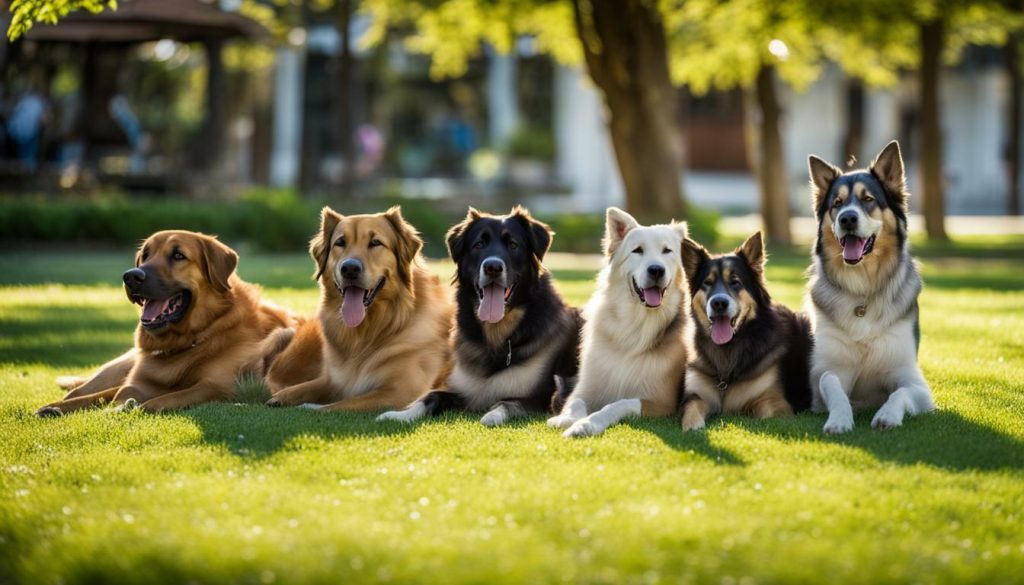
Planning Walks During Hot Weather
To ensure your dog’s safety during hot weather walks, it’s important to plan your outings carefully. Consider the temperature, humidity, and whether there is a breeze. Experts advise that temperatures up to 68F are generally safe for walks, but anything over 77F is considered risky. It is essential to be mindful of different dog sizes and breeds, as well as any underlying health issues.
To minimize risks during hot weather walks, here are some tips:
- Plan your walks in the early morning or late evening when temperatures are lower.
- Check the ground temperature before walking to ensure the pavement is not too hot for your dog’s paws. Hot pavement can cause burns and discomfort.
- Adjust the duration and intensity of the walk based on the heat. Shorter walks and less intense exercise are recommended to prevent overheating.
- Bring a collapsible water bowl and fresh water to keep your dog hydrated throughout the walk. Offering regular water breaks is essential.

Additionally, it is important to avoid leaving your dog in a hot car, even for a short period. The temperature inside a car can rise rapidly, leading to heatstroke and life-threatening conditions. If you need to run errands, find alternative arrangements for your dog’s care or consider bringing them along if it is safe and allowed.
During excessively hot weather, it may be necessary to adjust your dog’s exercise routine. Look for indoor activities or opt for less intense exercises to keep your dog cool and comfortable. Taking breaks for water and finding shaded areas can also help in keeping your dog’s body temperature down.
By planning your walks carefully and taking necessary precautions, you can help ensure the safety and well-being of your dog during hot weather walks.
Hydration and Water Breaks
Hydration is key when it comes to keeping your dog safe and comfortable during hot weather walks. Just like humans, dogs can become dehydrated and overheat in high temperatures, which can lead to serious health problems. Providing water breaks and keeping your pup well-hydrated is crucial to ensuring their well-being.
When preparing for a walk in hot weather, always bring a collapsible water bowl and fresh water for your dog. This will allow you to offer them hydration whenever they need it. It’s important to offer water breaks every 15-20 minutes, or more frequently if your dog is showing signs of thirst or fatigue. Pay close attention to their behavior and body language, as these can indicate whether they are in need of a break and some water.
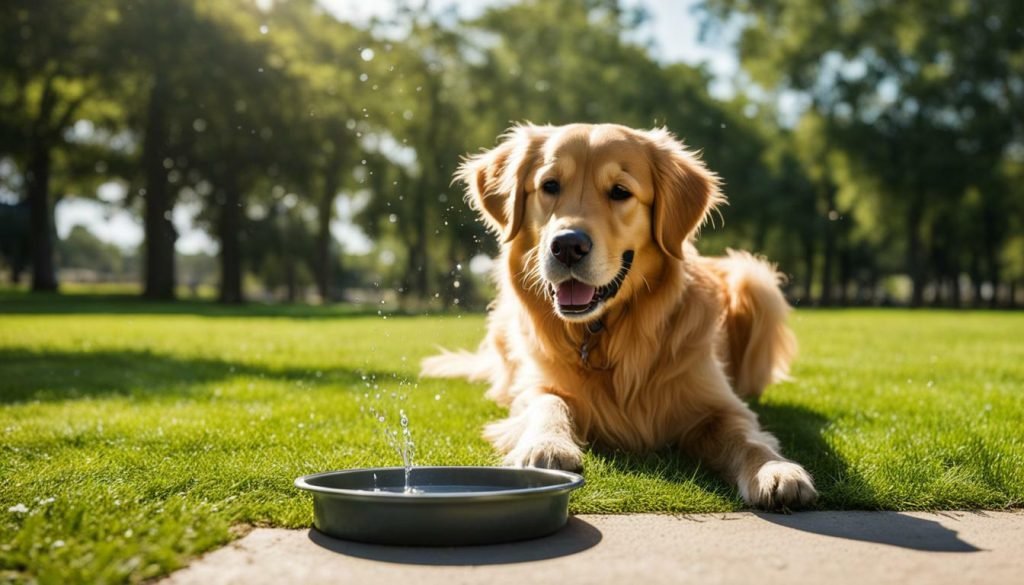
Remember, dogs do not sweat like humans do, and they rely on panting to cool down. Panting can lead to rapid moisture loss, making it even more important to provide them with ample water during hot weather walks. By being proactive about their hydration needs, you can help prevent heatstroke and other heat-related illnesses.
| Signs of Dehydration in Dogs | Signs of Heatstroke in Dogs |
|---|---|
|
|
Remember, prevention is always better than cure. Keep an eye out for the early signs of dehydration and heatstroke in your dog, and take immediate action to cool them down and provide them with water. If you suspect your dog is suffering from heatstroke, seek veterinary attention right away.
Summary:
When walking your dog in hot weather, prioritizing their hydration is essential. Bring a collapsible water bowl and fresh water to offer them regular water breaks. Look out for signs of dehydration and heatstroke, such as dry gums, excessive panting, and weakness. If these symptoms occur, take immediate action to cool your dog down and seek veterinary help if necessary. Taking precautions and ensuring your dog stays hydrated will help them stay safe and comfortable during hot weather walks.
Alternatives to Walking in Extreme Heat
When the heat becomes too intense for walking, consider these alternative activities to keep your dog active and engaged.
1. Indoor Playtime: Engaging your dog in indoor activities can provide exercise while avoiding the heat. Set up a designated play area in your home where your dog can safely run, jump, and play with their favorite toys. You can also include interactive games like hide-and-seek or puzzle toys to stimulate their mind.
2. Swimming Sessions: If you have access to a pool or a dog-friendly beach, swimming is an excellent way to keep your dog cool and active. Not only does it provide a full-body workout, but it also helps to relieve joint pain and stress. Ensure your dog’s safety by using a life vest if necessary and introduce them to the water gradually if they are new to swimming.
3. Mental Stimulation: Mental exercises can be just as exhausting for dogs as physical activities. Engage your dog’s mind by teaching them new tricks, practicing obedience commands, or playing interactive brain games. These activities not only provide mental stimulation but also help strengthen the bond between you and your dog.
4. Doggy Daycare or Playdates: If your dog enjoys the company of other dogs, consider enrolling them in a doggy daycare or organizing playdates with compatible furry friends. This allows your dog to socialize, burn off energy, and stay active in a supervised and controlled environment.
| Alternative Activity | Description |
|---|---|
| Indoor Playtime | Set up a designated play area at home and engage in interactive games and toys. |
| Swimming Sessions | Take your dog for a swim in a pool or dog-friendly beach to provide a full-body workout and keep them cool. |
| Mental Stimulation | Engage your dog’s mind with training sessions, obedience commands, and interactive brain games. |
| Doggy Daycare or Playdates | Enroll your dog in a daycare or organize playdates to allow socialization and supervised exercise. |
Remember, always prioritize your dog’s safety and well-being. If the heat is too intense, it’s better to postpone outdoor activities and opt for these alternative exercises. Enjoy quality time with your furry companion while keeping them happy, healthy, and cool.

Leaving your dog in a hot car, even for a few minutes, can have severe consequences. The temperature inside a car can rise rapidly, reaching dangerous levels within minutes. On a hot summer day, the temperature inside a parked car can increase by 20 degrees Fahrenheit in just 10 minutes, and up to 40 degrees Fahrenheit in an hour. This can quickly lead to heatstroke or even death for your furry friend.
It is essential to never leave your dog unattended in a parked car, even if you crack the windows. Dogs are unable to regulate their body temperature as effectively as humans, and their health can rapidly deteriorate in hot conditions. The risk is particularly high during the summer months when temperatures can soar, making it even more important to take the necessary precautions to protect your pet.
If you need to run errands or go somewhere that is not dog-friendly, it is best to leave your furry friend at home in a cool and comfortable environment. If you must travel with your dog, make sure to bring them inside with you wherever you go. Alternatively, consider finding pet-friendly establishments or arranging for a dog-sitter while you are out.
| Signs of Heatstroke in Dogs | What to Do If You See a Dog in a Hot Car |
|---|---|
|
|
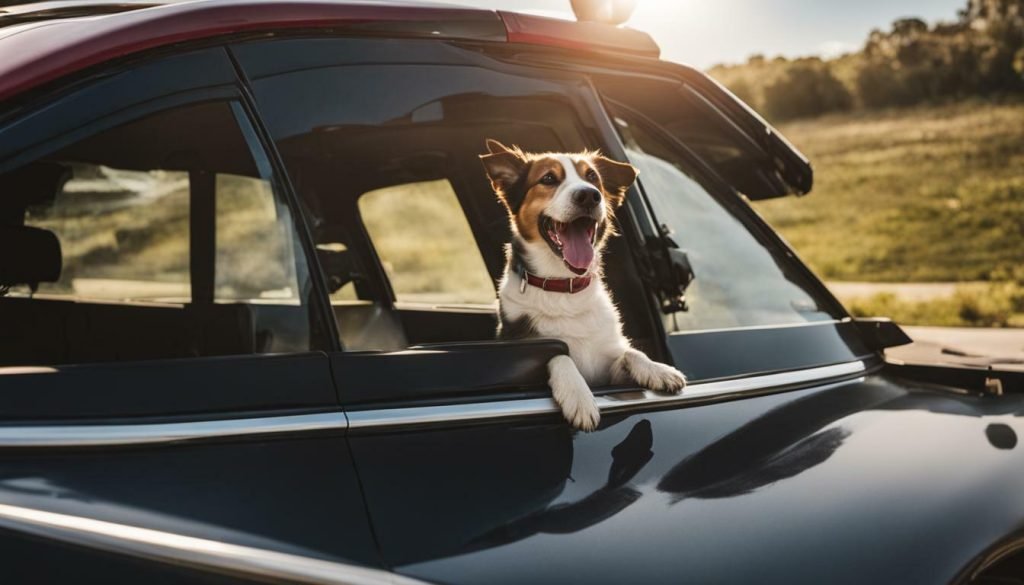
Remember, our dogs rely on us to keep them safe and comfortable. When it comes to hot cars, it’s better to be safe than sorry. Taking proactive steps to protect your pup from hot car dangers can help ensure their well-being and prevent a potential tragedy. Let’s be responsible pet owners and prioritize the safety of our four-legged friends, especially during the hot summer months.
Adjusting Walks for Hot Pavement
Walking your dog on hot pavement can be dangerous and cause burns on their sensitive paws. As responsible pet owners, it is important to take precautions and adjust your walks accordingly to ensure your dog’s safety and well-being. Here are some tips to help you navigate hot pavement during your daily walks:
- Check the ground temperature: Before stepping outside, test the pavement by placing the back of your hand on it. If it feels too hot for you, it will certainly be too hot for your furry friend. Consider walking on grass or dirt paths instead.
- Time your walks: Avoid walking your dog during the hottest parts of the day. Early mornings or late evenings when temperatures are cooler are ideal for outdoor activities. This not only helps to protect your dog’s paws but also prevents them from overheating.
- Shorten the duration: Reduce the length of your walks during hot weather to minimize your dog’s exposure to the scorching pavement. Remember, even a few minutes on hot pavement can cause burns or discomfort.
- Invest in protective gear: Consider using protective booties specially designed to shield your dog’s paws from hot surfaces. These booties provide an extra layer of insulation and prevent burns. Just make sure to properly introduce your dog to booties before heading out.
By following these simple adjustments, you can ensure your dog’s paws are safe from burns while still allowing them to enjoy their daily walks. Your furry companion will appreciate your extra care and attention.
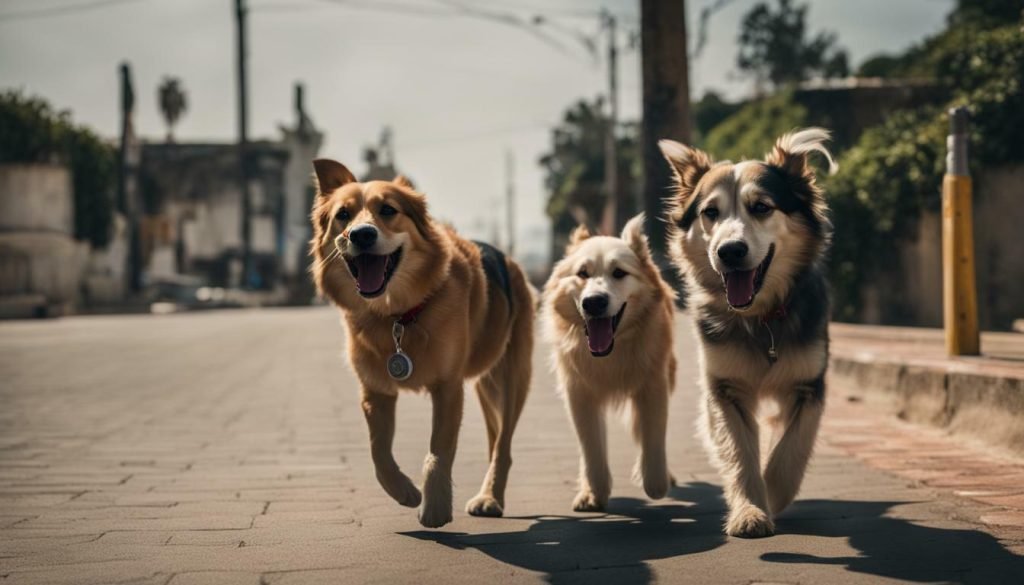
Remember, your dog’s safety is in your hands. Being proactive and adapting your walking routine to hot pavement conditions will help prevent unnecessary discomfort and potential injuries. Keep in mind that each dog is different, so it’s important to know your pet’s limits and observe their behavior closely during walks. By taking these precautions, you can continue to enjoy outdoor activities with your four-legged friend while keeping them safe and happy.
Taking Breaks and Staying Cool
To ensure your dog’s comfort during hot weather walks, it’s crucial to take breaks and provide opportunities for them to cool down. Excessive heat can put a strain on their bodies, leading to dehydration and heatstroke. By incorporating regular breaks into your walk routine, you can help prevent these issues and keep your furry friend safe.
During breaks, find a shaded area where your dog can rest and relax. This will give them a chance to cool off and lower their body temperature. You can also bring along a portable fan to provide additional relief from the heat. Remember, dogs cool off primarily through panting and sweating through their paw pads, so it’s important to give them the space and time they need to regulate their body temperature.
In addition to breaks, offering water to your dog is essential for hydration. Pack a collapsible water bowl and bring fresh water with you on your walks. Offer your dog small sips of water during breaks and whenever they seem thirsty. It’s important not to let them drink too much at once, as this can lead to stomach upset. Providing hydration throughout the walk will help keep your dog cool and prevent dehydration.
Dogs rely on their owners to make responsible choices for their well-being. By prioritizing breaks, shade, and hydration during hot weather walks, you are taking important steps to ensure their comfort and safety. Remember, your dog’s health and happiness should always be your top priority.
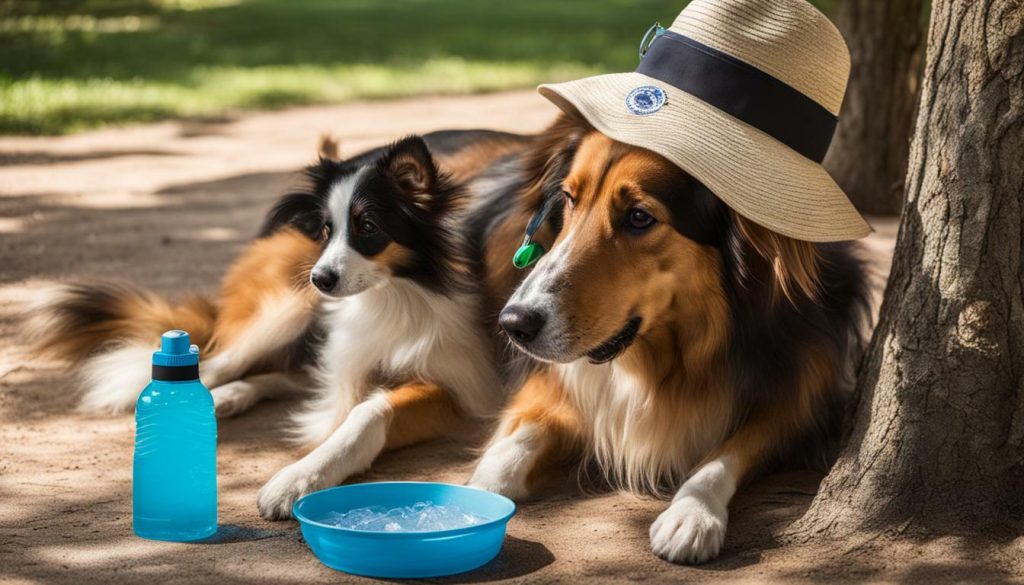
By understanding the risks of hot weather and taking necessary precautions, you can ensure the safety and well-being of your furry friend during walks in the heat. When it comes to walking dogs in hot weather, it’s important to consider the temperature, humidity, and whether there is a breeze.
Experts advise that temperatures up to 68F are generally safe for walks, but anything over 77F is considered risky. It’s essential to be mindful of different dog sizes and breeds, as well as any underlying health issues. Large, obese, flat-faced, and very young dogs are at a higher risk in temperatures above 75F.
To reduce risks during hot weather walks, it’s recommended to plan walks in the early morning or late evening when temperatures are lower. Checking the ground temperature before walking is important, as hot pavement can burn a dog’s paws. Adjusting the walking route and duration based on the heat is necessary, opting for shorter walks and less intense exercise.
Bringing along a collapsible water bowl and fresh water to keep the dog hydrated is crucial. Avoid leaving the dog in a hot car, even for a short time. Adjusting walk times and opting for alternative forms of exercise can be helpful during excessively hot weather. Taking breaks for water and walking on dirt paths instead of concrete can also aid in keeping a dog cool and comfortable.
FAQ
How hot is too hot to walk dogs safely?
Experts advise that temperatures up to 68F are generally safe for walks, but anything over 77F is considered risky.
What factors should I consider when walking dogs in hot weather?
It’s important to consider the temperature, humidity, and whether there is a breeze when determining if it’s safe to walk dogs in hot weather.
What are the temperature guidelines for dog walking?
Temperatures up to 68F are generally safe for walks, but anything over 77F is considered risky. It’s also important to check the ground temperature to avoid hot pavement injuring a dog’s paws.
Which dogs are at a higher risk in hot weather?
Large breeds, flat-faced breeds, obese dogs, and very young dogs are at a higher risk in temperatures above 75F.
How should I plan walks during hot weather?
Plan walks in the early morning or late evening when temperatures are lower. Adjust the duration and intensity of walks based on the heat.
How can I keep my dog hydrated during hot weather walks?
Bring a collapsible water bowl and fresh water to keep the dog hydrated. Take regular water breaks to ensure they stay cool and comfortable.
What are some alternatives to walking in extreme heat?
Find indoor activities or opt for less intense exercises during excessively hot weather to keep the dog cool and comfortable.
Why is it important to protect dogs from hot cars?
Leaving a dog in a hot car, even for a short time, can lead to heatstroke and be life-threatening. Always find alternative arrangements or alternatives to leaving a dog unattended in a hot car.
How can I adjust walks for hot pavement?
Adjust the walking route to avoid hot pavement and opt for dirt paths or grass instead to prevent burns on the dog’s paws.
How can I help my dog stay cool during hot weather walks?
Take breaks during walks to allow the dog to rest and cool down. Find shaded areas or bring along a portable fan to help keep them cool.






